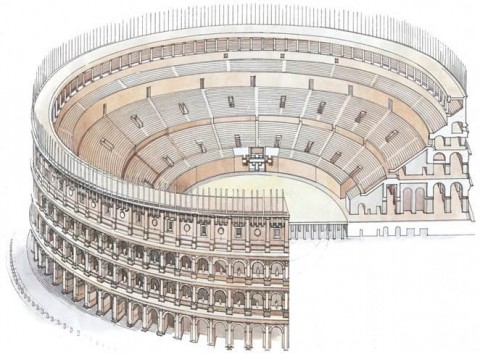Monday, December 23rd, 2013
The Vomitorium Myth
About a month ago, I was teaching my ancient art students about the Colosseum in Rome. I pointed out the exits located the certain seating sections, embedded within the tiers of seats. This exit, I explained to my students, is called a vomitorium because it is the place where the crowd can “spew forth” and exit the arena. In a way, I think vomitoria are a good example of how Romans were thoughtful engineers, even down to crowd control.
After explaining this term, though, I had a student raise his hand and explain that he learned in high school that a vomitorium is a specific room where Romans would go to vomit during a meal, so that the Romans could continue to eat more food afterward. Another student chimed in and mentioned that she learned this same information in a History of Theater class. I had never heard of this type of Roman room or an alternate definition of vomitorium apart from what I already knew in relation to the exits in an ampitheater, so after class I went online to check.
I quickly learned that these two students were familiar with a popular definition vomitorium that is incorrect. There are several sites which mention this misconception of the term, and THIS ONE seems to be the most concise in its explanation. More scholarly and detailed discussion is located in an archived webpage from the American Philological Association (a group dedicated to Greek/Roman classical studies). For a greater history of this term and its use, see the comment left by Bruce at the end of this post. Bruce points out that Macrobius (in his work “Saturnalia” from the 5th century CE) uses vomitoria to describe places where men “pour forth” to their seats.
It’s interesting that to date we do not have an example of the word vomitoria (or one of its variants like vomitorium) in earlier examples of Roman architectural writing. Perhaps later writers and historians, starting in the 17th and 18th centuries, latched onto this term because it also could wittily reference Roman dining habits. We do know that excessive eating and vomiting was sometimes described as part of the dining experience in ancient Rome (found in writings of Seneca, Suetonius, Cicero; see some more details HERE). There is even a BBC show for children includes a discussion of Roman dinner habits (see 1:21 in particular), although luckily the there isn’t a misuse of the term vomitorium here:
The American Philological Association pinpoints why the incorrect definition of vomitorium has become popular over recent centuries: “The prevalence of the [incorrect definition of] ‘vomitorium,’ attests to the flexibility of its appeal: a vivid metaphor for decadence, a proud emblem of emancipation from the conventions of society, an attempt to associate a new field with the prestige of antiquity. Although some authors do cite references, in each separate field the earliest source refers to the ‘Roman vomitorium’ as something that ‘everybody knows.'”
There is concern that it is hard to combat this incorrect definition of the myth with the widespread amount of information available online. On one hand, I can see how this is true, because I did come across inaccurate information. I do hope, though, that commonly-checked sites like Wikipedia (which currently discusses the misinterpretation of the term) can help to dispel these misconceptions. Any other thoughts on how to help clarify this widespread vomitorium myth and teach the correct meaning of the term? On one hand, I’m a little disappointed that I am out-of-touch enough with pop culture that I was not familiar with this myth before this quarter (even my husband said that he had heard of the “vomiting room”), but I’m also really pleased that I only was familiar with the correct definition of the term!
